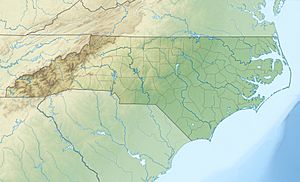Little Richardson Creek facts for kids
Quick facts for kids Little Richardson Creek |
|
|---|---|
|
Location of Little Richardson Creek mouth
|
|
| Other name(s) | Tributary to Richardson Creek |
| Country | United States |
| State | North Carolina |
| County | Union |
| City | Monroe |
| Physical characteristics | |
| Main source | Buffalo Creek divide about 1 mile southeast of Alton, North Carolina 648 ft (198 m) 34°52′43″N 080°31′18″W / 34.87861°N 80.52167°W |
| River mouth | Richardson Creek Lake Lee southeast of Monroe, North Carolina 490 ft (150 m) 34°57′46″N 080°30′44″W / 34.96278°N 80.51222°W |
| Length | 6.39 mi (10.28 km) |
| Basin features | |
| Progression | generally east |
| River system | Pee Dee |
| Basin size | 16.46 square miles (42.6 km2) |
| Tributaries |
|
| Waterbodies | Lake Monroe Lake Lee |
| Bridges | Bruce Thomas Road, E Sandy Ridge Road (x2), Stack Road, Macedonia Church Road, Medlin Road |
Little Richardson Creek is a small stream, about 6.39 miles (10.28 km) long. It flows into Richardson Creek in Union County, North Carolina. A creek like this is called a "tributary" because it feeds into a larger body of water.
Contents
Journey of the Creek
Little Richardson Creek begins its journey about one mile southeast of a place called Alton, North Carolina. It starts at an elevation of about 648 feet (197 meters) above sea level.
Where Does the Creek Flow?
From its start, the creek generally flows north. It travels through the landscape of Union County. Its path takes it towards Lake Lee, which is southeast of the city of Monroe, North Carolina.
Joining Richardson Creek
Little Richardson Creek eventually meets and joins Richardson Creek in Lake Lee. This meeting point is at an elevation of about 490 feet (149 meters). This means the water flows downhill from its source to its mouth.
Understanding the Watershed
A watershed is like a big bowl or area of land where all the rain and snow that falls drains into a common stream, river, or lake. The Little Richardson Creek has its own watershed.
Size and Features of the Watershed
The watershed for Little Richardson Creek covers an area of about 16.46 square miles (42.63 square kilometers). This entire area contributes water to the creek. On average, this region receives about 48.6 inches (123 cm) of rain and snow each year. About 41% of the land in this watershed is covered by forests. These forests help keep the water clean and healthy.
Why Watersheds Matter
Watersheds are very important for the environment. They help manage water flow and support different kinds of plants and animals. The health of the creek depends on the health of its entire watershed.
Creeks and Their Importance
Creeks like Little Richardson Creek are vital parts of our natural world. They are not just small streams; they play a big role in the larger water system.
Homes for Wildlife
These creeks provide homes and habitats for many different types of wildlife. Fish, insects, and other small creatures live in and around the water. Larger animals also visit creeks for drinking water.
Part of a Bigger System
Little Richardson Creek is part of the Pee Dee River system. This means its water eventually flows into Richardson Creek, which then flows into other rivers, and finally reaches the ocean. Every small creek is connected to a much larger network of waterways.



